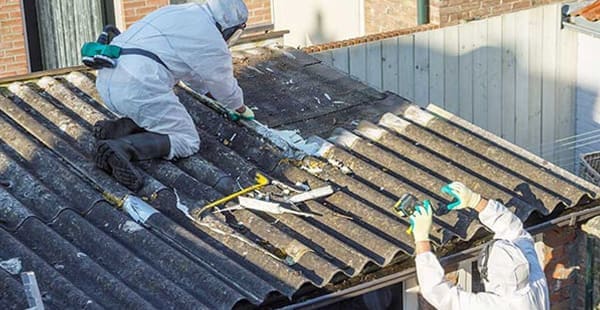Why Is It Important to Handle Asbestos Safely?
It’s important that professionals handle asbestos to ensure safety. When asbestos is mishandled, the fibers can become airborne. Airborne asbestos fibers can be inhaled and may become lodged in the linings around the lungs, abdomen or heart. Asbestos exposure can cause diseases such as asbestosis, lung cancer and mesothelioma.
Licensed workers can mitigate the risks of asbestos exposure. They are trained in the asbestos removal process and are aware of removal regulations designed to keep the public safe.
Why Homeowners Should Hire Asbestos Removal Companies
Homeowners and companies should hire licensed asbestos removal companies if materials on older buildings become worn or broken. Abatement professionals understand the laws and regulations surrounding the asbestos removal process. They can do asbestos mitigation safely and in line with relevant safety rules.
Asbestos removal contractors can also help homeowners assess the safety of their houses. Homes, schools and other structures built before the 1980s were often built with asbestos products.
Asbestos use has declined due to regulations, product bans and the use of safer alternatives. However, the general public may still be at risk of asbestos exposure from old products and materials. Asbestos-containing products in good condition and completely intact are generally considered safe. But renovation or demolition of older buildings may disturb asbestos-containing materials and release fibers into the air.
It is important for owners of older homes to hire licensed professionals to assess renovation and demolition projects. Workers at schools and other old buildings can contact their building managers if they suspect risks posed by potential asbestos products. Abatement professionals can safely perform asbestos encapsulation and asbestos waste removal.
How to Identify Asbestos Materials That May Need Removal
The best way to identify asbestos materials is to hire professionals experienced in handling and removing them. They can also handle the asbestos removal process for any dangerous materials they find. Asbestos may still be present in homes and buildings built before 1980.
Asbestos has been incorporated into thousands of products, such as building materials, automotive parts and consumer items. Industries frequently used asbestos for its durability and fire-resistant qualities. It was a popular additive to products, particularly from the 1930s to the 1980s.
In 1984, the U.S. Environmental Protection Agency (EPA) published a national survey of friable (easily crumbled) asbestos material in public buildings. At the time, the EPA stated 20% of public and private buildings contained friable asbestos. Many of the asbestos products identified in the report may also be present in private residential buildings.
Asbestos fibers are not visible to the human eye and can be difficult to identify. It’s important for people to be aware of common materials that may contain asbestos to help avoid exposure.
Asbestos was often used as a thermal insulator in public buildings, homes and schools. For example, asbestos coatings were sometimes applied to metal beams as a fireproofing material. Asbestos was also mixed into compounds and plasters used on walls and ceilings.
In the EPA 1984 survey report, the agency noted a variety of materials containing high amounts of asbestos. These included asbestos-containing pipe and boiler insulation and material used for fireproofing. The report also noted that construction workers and homeowners may still be at risk of asbestos exposure while performing renovations and remodels in older structures.
If an individual suspects asbestos is present, they can hire a professional to inspect the area and test damaged materials. If asbestos is identified, experienced professionals can handle the next steps, including proper removal and disposal.
How to Handle and Remove Asbestos
Asbestos should be handled and removed by professional contractors. An industry of inspectors, handlers and removers exists to help ensure airborne asbestos fibers do not pose a threat to the public. Homeowners can contact asbestos removal companies to handle any inspections or residential asbestos removals.
Handling asbestos products and materials can be dangerous. If the material is broken or damaged already, asbestos fibers can easily become airborne. Research indicates there is no safe level of asbestos exposure. Any amount of inhaled fibers may cause asbestos diseases to develop.
To help avoid exposure, asbestos should only be handled and removed by professionals with the appropriate training, licenses and certifications. Asbestos removal contractors and companies are highly trained to follow federal and state asbestos removal laws. These laws are designed to keep the public safe from potential exposures. They establish regulations for the inspection, handling and disposal of asbestos materials.
Asbestos Testing and Mitigation
Individuals should not touch or handle materials that may contain asbestos and should avoid the area until an asbestos removal contractor can test them. If the contractor identifies dangerous materials, they can also perform asbestos mitigation measures. Homeowners and building owners should treat any potential asbestos-containing material as dangerous.
A licensed professional will perform a visual inspection of the area first for any potential hazards. An inspector will then remove pieces of the questionable material. Lab technicians will analyze the samples to determine if asbestos is present.
If the samples contain asbestos, the asbestos inspector will suggest next steps. They may recommend the materials be encapsulated or completely removed from the area.
The Asbestos Removal Process
Two possible remedies are encapsulation or abatement (removal). If the professionals recommend encapsulation, they will seal the asbestos to keep the tiny fibers from becoming airborne. However, abatement may be their recommended solution if the material is damaged too severely. In that case, the asbestos will be removed entirely and relocated at landfills approved to receive asbestos.
Asbestos rules and regulations are also designed to protect workers. For example, technicians wear personal protective equipment when removing asbestos-containing materials.
After finishing tasks for the day, workers must follow strict protocols for decontamination. For instance, workers are required to change clothing and put any clothes that may have come in contact with asbestos fibers in approved containers. They are required to shower away from the work area in a clean room before dressing in fresh clothes.
Companies can safely dispose of the asbestos materials after removing it from the site. They must strictly follow state and federal regulations and laws.
How to Dispose of Asbestos After Abatement
After removing the asbestos material, abatement professionals transport them to a qualified landfill approved to receive the waste.
Regulations for asbestos disposal can vary by the specific state or region affected. It is essential to verify the regulations for the area where work is being done. In some areas, regulations may require that the asbestos-containing materials must be wet and then encased in plastic before being moved to a disposal site. The encased asbestos would then be buried at the designated landfill.
Can Asbestos Be Recycled?
It is possible that asbestos may be recycled in some cases. In one method, high heat changes the asbestos fibers into an inert silicate glass. The asbestos fibers are destroyed and the remaining material is non-hazardous.
In one study, researchers submerged metals with asbestos coatings into a sodium hydroxide (NaOH) bath. This method changed the asbestos into a silica gel that could then be turned into glass.
Efforts to develop recycling technology and processes for asbestos are underway. Recycling could reduce costs for handling asbestos. It could also help prevent asbestos materials from being disposed of improperly.
Improper Abatement and Illegal Dumping of Asbestos Products
Improper abatement and illegal dumping of asbestos may result in legal consequences, including fines and criminal prosecution. Exemptions to abatement laws may exist for single-family homes, but states with these exemptions may still advise homeowners to hire accredited professionals. Doing so minimizes the risk of exposure in the home.
Asbestos projects involving multi-family homes and other buildings are heavily regulated. Asbestos abatement companies working these projects can be fined or penalized severely for non-compliance with laws and procedures. The regulations regarding asbestos abatement aim to prevent improper abatement that may cause occupational exposure and place the public in unnecessary jeopardy.
If a person believes improper asbestos disposal has taken place, they can contact:
- The EPA on its website or by calling 1-800-368-5888
- The Occupational Safety and Health Administration (OSHA) on its website or by calling 800-321-6742
- The state or regional Department of Environmental Quality (DEQ)
Some state’s environmental departments may have names other than DEQ. Others may have different departments handle asbestos hazards.
Rules and Regulations for Handling Asbestos
Federal and state regulations dictate how to handle asbestos found in schools, homes and other buildings. These laws are in place to protect the general public from being exposed to asbestos.
Some rules are for specific locations and building types. Others are more universal to more completely protect people from being unnecessarily exposed.
Although there are do-it-yourself asbestos abatement guides online, the EPA recommends the general public does not attempt to handle asbestos. Individuals who mishandle asbestos may face dangerous exposure.
These various laws and regulations dictate how and where asbestos can be disposed of, how it must be handled and rules professionals must follow. These regulations help keep both workers and the general public safe from exposure to the dangerous mineral.
Tips and Resources for Asbestos Remediation
Homeowners are wise to research companies or asbestos contractors to find the right one for their projects. Homeowners may want to receive multiple bids from abatement companies and request a written work plan from the contractors. This plan should describe in detail the cleaning and removal methods they will use.
The written plans should verify that the asbestos removal methods meet all state and federal regulations. Asbestos removal contractors should also provide references from other customers and proof of required certifications and accreditations. Asbestos removal companies and contractors are responsible for following all regulations and laws to ensure the job is completed correctly.
Homeowners and others can learn more about how to have asbestos safely removed from a home or building.
Additional resources for handling, removing and disposing of asbestos include:
- The Consumer Product Safety Commission’s Asbestos in the Home guide
- The EPA’s Asbestos Laws and Regulations overview
- Mesothelioma.com’s Homeowners Insurance & Asbestos Removal Costs guide
- Mesothelioma.com’s How to Stay Safe During Asbestos Cleanups guide
- Mesothelioma.com’s 25 Questions to Ask an Abatement Professional When Asbestos Is Found
- OSHA’s asbestos Fact Sheet
Before renovating or demolishing an older building, owners should contact an asbestos professional to test for asbestos. Avoiding asbestos exposure and ensuring safe handling and removal of asbestos can be achieved by following safety procedures and observing regulations.
Common Questions About Handling, Removing and Disposing of Asbestos
- How is asbestos destroyed?
Asbestos is often disposed of rather than destroyed completely. This process usually includes wetting the material. Then, asbestos abatement contractors remove the material and package it securely in sealed, labeled containers. They dispose of the containers at certified landfills.
- What can you do with damaged asbestos?
If an individual discovers damaged or disturbed asbestos, they should avoid touching it and stay away from the general area. They should then contact a professional asbestos abatement company or contractor to inspect the material and determine the next steps.
- Can chemicals be used to destroy or recycle asbestos?
Asbestos can be destroyed with certain chemicals. A sodium hydroxide solution can be used to break down asbestos and turn it into non-hazardous glass. Organic acids can also be used to destroy asbestos fibers. Any handling of asbestos should always be done by asbestos abatement professionals.
- What is the difference between abatement and encapsulation?
Abatement is the removal of asbestos and asbestos-containing materials. Encapsulation is when asbestos is not removed but is sealed with a protective covering to keep the fibers from being released into the air. An asbestos removal company can determine which process will best suit a given scenario.





